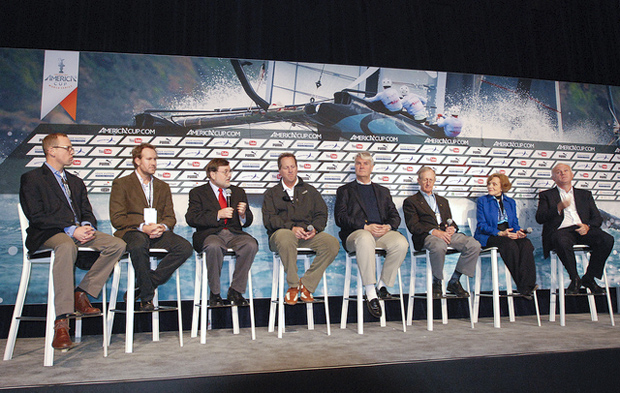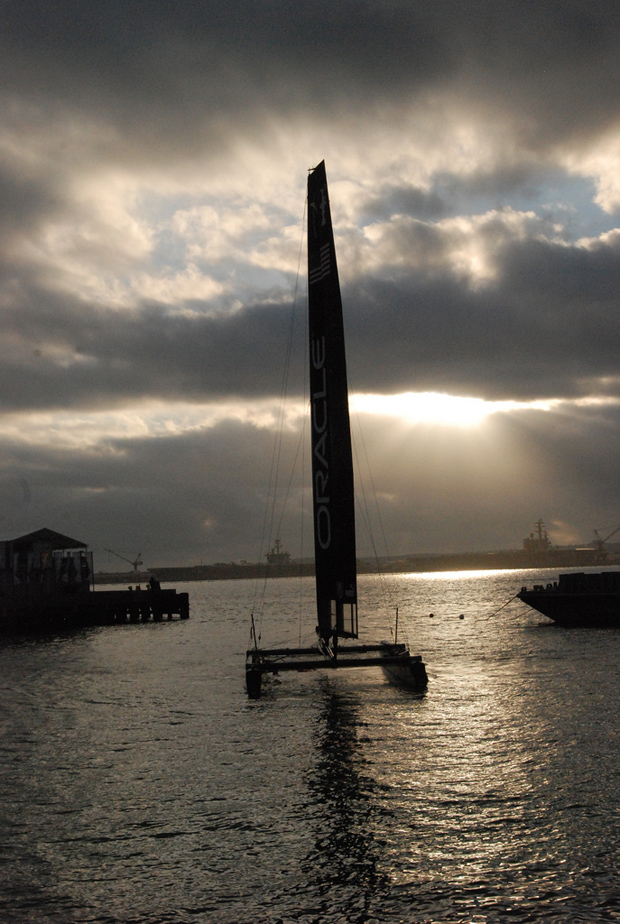
By:
- Cindy Clark
Published Date
By:
- Cindy Clark
Share This:
America’s Cup Sails into San Diego Bay—and Scripps Oceanography Makes It ‘More Than a Sport’

Press Conference Panel
Howling winds and pouring rain didn’t deter the crews of sailors and crowds of sailing fans who lined San Diego Bay for the start of the America’s Cup World Series during an unseasonably cool Saturday in mid-November. Clearer skies prevailed and the races took off.
Like America’s Cup today, Scripps Institution of Oceanography has been intertwined with San Diego Bay for many decades. Since Scripps’ founding in 1903, the institution has expanded from a local coastal biological laboratory to a global institution transforming the study of the oceans and Earth for the benefit of society and the environment. So, when America’s Cup selected San Diego as the third stop on its inaugural World Series of sailing, leading up to the America’s Cup Finals and Challenger Series in San Francisco in 2013, Scripps was invited to be part of the action.

Scripps Oceanography was selected to be the local collaborator in America’s Cup latest outreach venture, the Healthy Ocean Project,
a global initiative to educate the world’s populations about the issues facing the oceans and to inspire action. Driven by their commitment to have the America’s Cup be “more than a sport,” the organizers called upon Scripps’ expertise in ocean science for their new initiative.
Just like the America’s Cup teams and sailing enthusiasts around the world, Scripps shares a love of the oceans. Like the sailors who take pride in their sleek state-of-the-art sailboats, Scripps ships, docked on San Diego Bay, are a source of pride for UC San Diego. But instead of racing against the wind, Scripps’ vessels steam smoothly (most of the time) across the globe to deploy instruments and conduct scientific investigations in the world’s oceans. An additional vessel, an "Ocean Class" research ship awarded to Scripps by the U.S. Navy, will join Scripps' research fleet in 2016. Over the past century, Scripps scientists have sailed more than six million nautical miles in pursuit of knowledge about the ocean.
Today, the America’s Cup Healthy Ocean Project has sounded an alarm that the oceans—sailors’ playgrounds and ocean researchers’ laboratories—are in trouble. Pollution, overfishing, warming, and acidification of the oceans are pushing the seas into states they’ve never seen before. During race week, America’s Cup dedicated a day to its Healthy Ocean Project with Scripps science in the spotlight.
The 2009 SEAPLEX voyage led by Miriam Goldstein and other Scripps graduate students was a groundbreaking voyage that investigated the problems and impacts of plastic debris in the Great Pacific Garbage Patch. Goldstein, along with global ocean ambassador Sylvia Earle, took to the main stage in America’s Cup Village and wowed an attentive, ocean-loving crowd with the startling findings of the SEAPLEX cruise.
“Mostly what’s out there on top of the oceans are these tiny plastic pieces, a soup, that goes on and on and on for thousands of miles,” Goldstein told the crowd while holding up a sample jar loaded with marine debris. “So, there’s a lot of plastic out there.”
During America’s Cup, a 3-D SEAPLEX exhibit usually on display in the galleria at Birch Aquarium at Scripps was a centerpiece exhibit in the exhibition hall on Broadway Pier.
Staffed by an enthusiastic cadre of Scripps graduate students and Birch Aquarium instructors and volunteers leading interactive activities for visitors, the exhibit hall bustled with talk about graduate research topics, membership programs at Scripps, and how to support Scripps Institution of Oceanography.
Scripps Director Tony Haymet participated in a press conference to launch the America’s Cup Healthy Ocean Project. He pointed out that the sailing world can see Scripps science at work through the Southern California Coastal Ocean Observing System and Coastal Data Information Program and their important wind and ocean current data. Education, he said, is crucial to encouraging young learners to know more about the oceans and the opportunities to study in ocean-related fields.
“We’re doing our part to reach out to all of today’s kids to let them know that they can have a great career and save the oceans at the same time,” Haymet told the press, referring to Scripps’ comprehensive undergraduate, graduate, and K-12 education programs.
Collaborations with ambitious programs such as the America’s Cup Healthy Ocean Project have become important to Scripps as traditional sources of funds to support science and education dwindle. America’s Cup provides access to partners who share the mission of educating future generations about the powers and perils of the oceans. Joining forces enables resources to be shared in ways that leverage and maximize outreach to a growing community of those more aware than ever of the threats facing our planet.
Share This:
You May Also Like
Stay in the Know
Keep up with all the latest from UC San Diego. Subscribe to the newsletter today.


